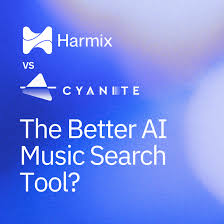In an age where content is king and music fuels everything from TikToks to ad campaigns, creators and marketers are drowning in choices. That’s where AI music search tools like Cyanite and Harmix come in. They promise to make music discovery smarter, faster, and more relevant—whether you’re hunting for the perfect song for a fashion ad or curating a gaming soundtrack.
But between Cyanite and Harmix, which platform offers better music tagging, emotional recognition, AI-driven recommendations, and integration for commercial use?
This in-depth comparison pits Cyanite vs. Harmix in a head-to-head analysis, helping you decide which tool aligns best with your creative and business goals.

Explore:Best AI Music Search Tools in 2025
Cyanite: Metadata-Driven Music Search with Deep AI Analysis
Cyanite.ai is an AI music analysis platform that breaks down songs into emotional, lyrical, and acoustic attributes. Used by major labels like Universal Music Group, Cyanite is especially popular for music libraries and sync licensing teams who want automated metadata tagging.
Key Features:
Emotion-based search (e.g., uplifting, melancholic)
BPM, key, genre, and mood detection
Lyrics analysis (mood, topics, language detection)
Spotify playlist matching
API integration for music libraries
Batch metadata processing
Use Case:
A music licensing company with 10,000+ songs uses Cyanite’s API to automatically tag songs with mood, tempo, and genre, saving weeks of manual work.
Harmix: AI-Powered Music Selection for Video Creators
Harmix.ai, on the other hand, is designed for video creators and brands looking to find the perfect song for their visuals. It focuses more on music recommendation based on video mood and pacing, making it ideal for ad agencies, editors, and small teams.
Key Features:
Upload a video, get AI-recommended tracks
Scene detection and mood matching
Pre-cleared royalty-free music
Audio-to-video tempo sync
Emotion-matching engine
Use Case:
A YouTuber uploads a 60-second travel video. Harmix analyzes scene cuts and mood, then recommends four tracks that match the pacing and emotional tone.
Cyanite vs. Harmix: Feature-by-Feature Comparison
| Feature | Cyanite | Harmix |
|---|---|---|
| Target Users | Music libraries, labels, sync teams | Creators, editors, marketers |
| Search Method | Tag, emotion, and text-based | Visual + mood-based |
| Metadata Generation | Advanced + batch processing | Not core feature |
| API Integration | Yes (robust) | Limited (beta stage) |
| Licensing | B2B platform, BYO tracks | Built-in royalty-free music catalog |
| Output Use Case | Cataloging, curation, licensing | Direct-to-video editing, social media |
| Supported Input | Audio, lyrics | Video (MP4), text |
| Price | Custom / Enterprise-tier | Free trials + affordable tiers |
Performance & Accuracy
Cyanite excels at:
High-accuracy tagging, especially for large catalogs. Its emotion detection is nuanced and includes valence/arousal modeling. Perfect for enterprise workflows.Harmix excels at:
Instant audio-to-video matching. It understands how audio should “feel” in a scene and auto-suggests accordingly. Its simplicity makes it creator-friendly.
User Experience
Cyanite has a more technical interface built for B2B integrations. Requires some onboarding but is scalable and reliable.
Harmix feels intuitive—upload, preview, and download. Ideal for solo creators and small teams without technical backgrounds.
Pricing
Cyanite.ai
Custom enterprise pricing
Free demo available
Ideal for high-volume users (labels, libraries)
Harmix.ai
Freemium model with pay-per-track licensing
Subscriptions for teams available
Clear licensing structure for online content
Pros and Cons
Cyanite Pros:
Accurate, batch-level music tagging
Powerful API integration
Trusted by global music companies
Excellent for metadata enrichment
Cyanite Cons:
Not built for video-based workflows
No built-in royalty-free music catalog
Steeper learning curve
Harmix Pros:
Simple, intuitive for non-musicians
Great for short-form video creators
Fast, visual-based recommendations
Built-in legal music library
Harmix Cons:
Limited to its own catalog
No advanced metadata export
Less suitable for large-scale catalog processing
Which One Should You Use?
Use Cyanite if you’re a music professional, label, or library managing thousands of tracks and need advanced tagging, emotion analysis, and API access.
Use Harmix if you’re a content creator, marketer, or agency looking for instant music matches for your videos—without worrying about copyright.
Some teams may benefit from using both—Cyanite for internal organization and Harmix for external-facing content production.
Conclusion: Cyanite vs. Harmix Verdict
Both Cyanite and Harmix bring unique strengths to the table. Cyanite is a data powerhouse, ideal for large-scale catalog management. Harmix, meanwhile, democratizes music curation for creators with AI-powered, video-first recommendations.
If you’re a creator focused on video output, Harmix will save you time and legal headaches. If you’re organizing or monetizing music libraries at scale, Cyanite’s metadata intelligence can’t be beat.
The best choice depends on your workflow—and your end goal.
FAQs
Q1: Can I use Cyanite to find songs for TikTok videos?
Not directly—it’s more for tagging and analyzing your own music. You’d need to use another tool to sync to video.
Q2: Does Harmix let me upload my own music?
Currently, no. You choose from their built-in royalty-free catalog.
Q3: Can I integrate Cyanite into my music website?
Yes. The Cyanite API allows full integration into digital platforms or internal databases.
Q4: Is Harmix free to use?
It offers free previews and limited exports. Full downloads may require a subscription or licensing fee.
Q5: Can I combine Harmix and Cyanite in my workflow?
Yes. Use Cyanite to tag and analyze your music, and Harmix to match tracks to video content.
Learn more about AI MUSIC








